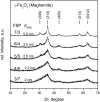Development and characterization of a Versatile Engineered Nanomaterial Generation System (VENGES) suitable for toxicological studies
- PMID: 20701428
- PMCID: PMC4425191
- DOI: 10.3109/08958378.2010.499385
Development and characterization of a Versatile Engineered Nanomaterial Generation System (VENGES) suitable for toxicological studies
Abstract
A novel system for generation of engineered nanomaterials (ENMs) suitable for in situ toxicological characterization within biological matrices was developed. This Versatile Engineered Nanomaterial Generation System (VENGES) is based on industry-relevant, flame spray pyrolysis aerosol reactors that can scaleably produce ENMs with controlled primary and aggregate particle size, crystallinity, and morphology. ENMs are produced continuously in the gas phase, allowing their continuous transfer to inhalation chambers, without altering their state of agglomeration. Freshly generated ENMs are also collected on Teflon filters for subsequent physicochemical and morphological characterization and for in vitro toxicological studies. The ability of the VENGES system to generate families of ENMs of pure and selected mixtures of iron oxide, silica, and nanosilver with controlled physicochemical properties was demonstrated using a range of state-of-the-art-techniques. Specific surface area was measured by nitrogen adsorption using the Brunauer-Emmett-Teller method, and crystallinity was characterized by X-ray diffraction. Particle morphology and size were evaluated by scanning and transmission electron microscopy. The suitability of the VENGES system for toxicological studies was also shown in both in vivo and in vitro studies involving Sprague-Dawley rats and human alveolar-like monocyte derived macrophages, respectively. We demonstrated linkage between physicochemical ENM properties and potential toxicity.
Figures










Similar articles
-
Development of reference metal and metal oxide engineered nanomaterials for nanotoxicology research using high throughput and precision flame spray synthesis approaches.NanoImpact. 2018 Apr;10:26-37. doi: 10.1016/j.impact.2017.11.007. Epub 2017 Dec 2. NanoImpact. 2018. PMID: 30035243 Free PMC article.
-
An integrated methodology for assessing the impact of food matrix and gastrointestinal effects on the biokinetics and cellular toxicity of ingested engineered nanomaterials.Part Fibre Toxicol. 2017 Oct 13;14(1):40. doi: 10.1186/s12989-017-0221-5. Part Fibre Toxicol. 2017. PMID: 29029643 Free PMC article.
-
A novel platform for pulmonary and cardiovascular toxicological characterization of inhaled engineered nanomaterials.Nanotoxicology. 2012 Sep;6(6):680-90. doi: 10.3109/17435390.2011.604439. Epub 2011 Aug 2. Nanotoxicology. 2012. PMID: 21809902 Free PMC article.
-
Nanomaterial toxicity testing in the 21st century: use of a predictive toxicological approach and high-throughput screening.Acc Chem Res. 2013 Mar 19;46(3):607-21. doi: 10.1021/ar300022h. Epub 2012 Jun 7. Acc Chem Res. 2013. PMID: 22676423 Free PMC article. Review.
-
Physicochemical properties determine nanomaterial cellular uptake, transport, and fate.Acc Chem Res. 2013 Mar 19;46(3):622-31. doi: 10.1021/ar300031y. Epub 2012 Aug 14. Acc Chem Res. 2013. PMID: 22891796 Free PMC article. Review.
Cited by
-
Effects of copy center particles on the lungs: a toxicological characterization using a Balb/c mouse model.Inhal Toxicol. 2013 Aug;25(9):498-508. doi: 10.3109/08958378.2013.806614. Epub 2013 Jul 29. Inhal Toxicol. 2013. PMID: 23895351 Free PMC article.
-
Development of reference metal and metal oxide engineered nanomaterials for nanotoxicology research using high throughput and precision flame spray synthesis approaches.NanoImpact. 2018 Apr;10:26-37. doi: 10.1016/j.impact.2017.11.007. Epub 2017 Dec 2. NanoImpact. 2018. PMID: 30035243 Free PMC article.
-
ZnO nanoparticle preparation route influences surface reactivity, dissolution and cytotoxicity.Environ Sci Nano. 2018 Feb 1;5(2):572-588. doi: 10.1039/C7EN00888K. Epub 2018 Jan 5. Environ Sci Nano. 2018. PMID: 29479436 Free PMC article.
-
Silica coating influences the corona and biokinetics of cerium oxide nanoparticles.Part Fibre Toxicol. 2015 Oct 12;12:31. doi: 10.1186/s12989-015-0106-4. Part Fibre Toxicol. 2015. PMID: 26458946 Free PMC article.
-
Nanoparticle-nanoparticle interactions in biological media by atomic force microscopy.Langmuir. 2013 Sep 10;29(36):11385-95. doi: 10.1021/la4019585. Epub 2013 Aug 26. Langmuir. 2013. PMID: 23978039 Free PMC article.
References
-
- Aitken RJ, Chaudhry MQ, Boxall ABA, Hull M. Manufacture and use of nanomaterials: current status in the UK and global trends. Occup Med. 2006;56:300–306. - PubMed
-
- Beck BD, Brain JD, Bohannon DE. An in vivo hamster bioassay to assess the toxicity of particulates for the lungs. Toxicol Appl Pharmacol. 1982;66:9–29. - PubMed
-
- Brain JD, Curran MA, Donaghey T, Molina R. Biologic responses to nanomaterials depend on exposure, clearance, and material characteristics. Nanotoxicology. 2009;3:1–7.
-
- Camenzind A, Schweizer T, Sztucki M, Pratsinis SE. Structure & Strength of Silica-PDMS Nanocomposites. Polymer. 2010;51:1796–1804.
Publication types
MeSH terms
Substances
Grants and funding
LinkOut - more resources
Full Text Sources
